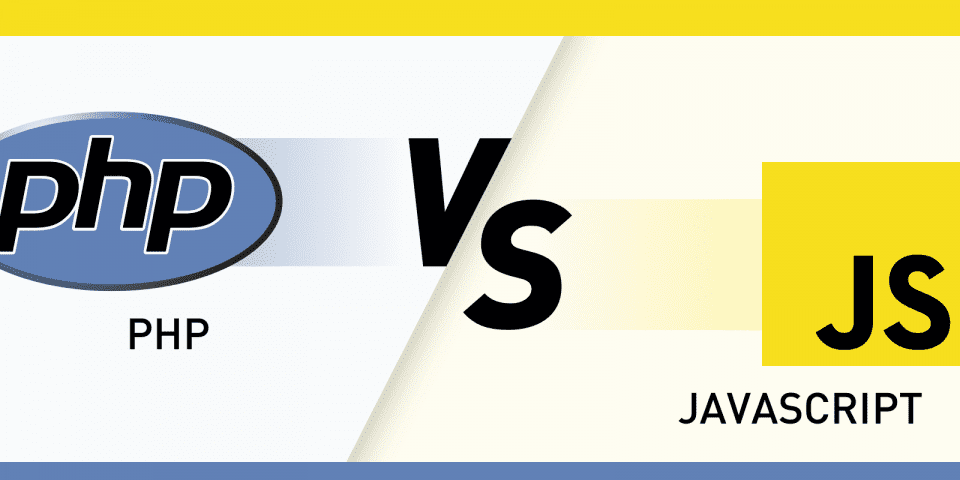PHP and JavaScript are two of the most popular programming languages on the web today. Both necessary for developing dynamic and interactive websites and web applications. While both are integral to web development, they serve different purposes and possess unique characteristics. They are used by developers to build famous websites like Facebook, Wikipedia, WordPress, and more. This article looks at the differences between PHP vs JavaScript and discusses when to use each of them.
What is PHP?
PHP, originally an acronym for “Personal Home Page,” now stands for “Hypertext Preprocessor.” It is a server-side scripting language primarily used for creating web pages, managing databases, and building web applications. web development but also serves as a general-purpose programming language. PHP code is executed on the server, generating HTML content sent to the client’s web browser. It can run on various operating systems such as Microsoft Windows, macOS, Linux, UNIX, and web servers like Apache and IIS. It doesn’t depend on any specific platform.
- PHP scripts start with <?php and end with ?>.
- Variables in PHP begin with $ followed by the variable name.
- Each statement in PHP code ends with a semicolon (;).
What is JavaScript?
JavaScript, often abbreviated as JS, is a most popular and commonly used scripting languages. JavaScript is a programming language often used for making dynamic web pages, web and mobile apps, and games. Unlike PHP, which operates on the server side, JavaScript runs on the client side, meaning the user’s web browser executes it. JavaScript enables dynamic content, interactivity, and real-time updates without reloading the entire webpage.
- Statements in JavaScript are instructions to the browser and are divided by a semicolon (;).
- Variables can be created using let, const, or var (though var is less common in modern JavaScript).
- Functions are used to save blocks of code that can be used again.
PHP vs JavaScript: Differences
Regarding web development, PHP and JavaScript are two prominent languages that serve different purposes and operate in different environments. Understanding the differences between PHP and JavaScript is essential for developers to make informed decisions about which language to use for specific tasks within a project.
In this section, we’ll delve into the nuances of PHP and JavaScript, exploring their disparities across various aspects of web development.
- Language Type
- Performance & Speed
- Open Source
- Availability
- Concurrency
- Database Interaction and Integration
- Learning Difficulty
- Syntax
- Runtime Environments
- Simplicity
- Platform Independent
- Security
- Popular frameworks
- Long-Term Support and Maintenance
| Feature | PHP | JavaScript |
| Language Type | Server-side scripting language | Client-side scripting language |
| Performance & Speed | Generally slower than JavaScript | Generally faster than PHP |
| Open Source | Yes | Yes |
| Availability | Widely available for web development | Widely available for web development |
| Concurrency | Limited support for concurrency | Better support for concurrency |
| Database Interaction | Strong support for various databases | Limited database support (mostly relies on backend) |
| Learning Difficulty | Generally easier to learn | Moderate learning curve |
| Syntax | C-like syntax | C-like syntax |
| Runtime Environments | Requires a server environment (e.g., Apache, Nginx) | Can run in any modern web browser |
| Simplicity | Generally simpler for server-side tasks | Suitable for both simple and complex tasks |
| Platform Independent | Runs on multiple platforms (Windows, Linux, macOS) | Runs on any platform with a web browser |
| Security | Requires proper configuration for security | Vulnerable to client-side attacks, needs proper security measures |
| Popular Frameworks | Laravel, Symfony, CodeIgniter, etc. | React, Angular, Vue.js, Node.js, etc. |
| Long-Term Support & Maintenance | Generally well-supported with long-term releases | Rapidly evolving with varying levels of support |
Language Type: PHP vs JavaScript
PHP and JavaScript differ fundamentally in their execution environments. PHP is a server-side scripting language that runs on the web server and generates HTML content dynamically before sending it to the client’s web browser.
On the other hand, JavaScript is a client-side scripting language that runs within the user’s web browser, enabling dynamic interactions and real-time updates without reloading the entire webpage. This distinction in execution environments influences how each language is used and the types of tasks they excel at within web development.
Performance & Speed: PHP vs JavaScript
Performance and speed are critical considerations in web development, particularly for applications that require real-time updates and responsiveness. JavaScript often outperforms PHP for client-side tasks because it can execute directly within the user’s web browser, leveraging the browser’s processing power and minimizing server round-trips. It makes JavaScript ideal for implementing dynamic user interfaces and interactive features that enhance the user experience.
On the other hand, PHP typically offers faster processing times for server-side operations, as it executes on the web server before sending the output to the client. This makes PHP well-suited for tasks such as server-side rendering of web pages, processing form submissions, and interacting with databases. However, advancements in JavaScript engines and server-side JavaScript platforms like Node.js have narrowed the performance gap between PHP and JavaScript for specific tasks, making JavaScript increasingly competitive in server-side scenarios as well.
Open-Source vs. Open Standard
Both PHP and JavaScript are open-source languages, meaning their source code is freely available for anyone to use, modify, and distribute. This openness has fostered vibrant developer communities around both languages, resulting in extensive documentation, libraries, frameworks, and third-party tools that enhance productivity and facilitate collaboration.
PHP has a long history of open-source development, with a dedicated community that actively contributes to the language’s evolution and maintenance. Numerous frameworks and content management systems (CMS) built on PHP, such as WordPress, Drupal, and Joomla, further demonstrate the breadth and depth of PHP’s open-source ecosystem.
JavaScript’s open-source ecosystem is equally robust, with a vast array of libraries and frameworks catering to different web development aspects. Popular JavaScript frameworks like React, Angular, and Vue.js have revolutionized front-end development, providing developers with powerful tools for building dynamic user interfaces and single-page applications. Additionally, Node.js has emerged as a prominent server-side JavaScript platform, enabling developers to use JavaScript for full-stack development and leverage the same language and ecosystem on both the client and server sides.
Availability: PHP vs JavaScript
PHP enjoys widespread availability, as most web hosting providers support it and integrate it seamlessly with popular web servers like Apache and Nginx. Deploying PHP applications typically requires minimal configuration on the server side, making it accessible to developers of all skill levels.
JavaScript’s availability is even more ubiquitous, as all modern web browsers natively support it without requiring additional installations. Furthermore, the rise of cloud computing platforms and serverless architectures has made deploying and scaling JavaScript applications in the cloud more accessible than ever.
Concurrency: PHP vs JavaScript
Concurrency refers to a program’s ability to execute multiple tasks simultaneously, which is crucial for handling concurrent requests and optimizing performance in web applications. PHP traditionally lacked robust support for concurrency, as it relied on a synchronous execution model that processed one request at a time. However, advancements such as PHP-FPM (FastCGI Process Manager) have improved PHP’s handling of concurrent requests by managing multiple PHP processes asynchronously and handling incoming requests more efficiently.
JavaScript, particularly with the advent of asynchronous programming techniques like Promises and async/await, excels in handling concurrency on both the client and server sides. Asynchronous operations in JavaScript allow non-blocking I/O operations, enabling applications to perform multiple tasks concurrently without blocking the main execution thread. This makes JavaScript well-suited for building highly scalable and responsive web applications that handle many concurrent users and requests.
Database Interaction and Integration
Both PHP and JavaScript offer robust support for interacting with databases, enabling developers to store, retrieve, and manipulate data seamlessly within web applications. PHP has long been associated with databases like MySQL, PostgreSQL, and SQLite, with built-in functions and extensions that facilitate database connectivity and query execution. PHP frameworks like Laravel and Symfony further streamline database interaction by providing ORM (Object-Relational Mapping) libraries and abstraction layers that simplify database operations and promote code reusability.
JavaScript’s database integration capabilities have evolved significantly with the advent of server-side JavaScript platforms like Node.js. With Node.js, developers can use JavaScript to interact with various databases, including MongoDB, PostgreSQL, MySQL, and Redis, using libraries like Mongoose, Sequelize, and Redis-Client. Additionally, JavaScript frameworks like Meteor and MEAN (MongoDB, Express.js, AngularJS, Node.js) stack provide integrated solutions for building full-stack JavaScript applications with seamless database connectivity and synchronization between the client and server sides.
Learning Difficulty: PHP vs JavaScript
The learning difficulty of a programming language can significantly impact its adoption and accessibility to developers, particularly those new to web development. PHP is often considered more accessible for beginners due to its straightforward syntax and extensive documentation, making it easy to learn and start building dynamic web applications. PHP’s focus on web development tasks, such as handling form submissions, processing user input, and generating HTML content dynamically, aligns closely with the requirements of most web projects, making it an ideal choice for aspiring web developers.
JavaScript typically has a moderate learning curve,, especially for developers new to programming or from backgrounds that don’t involve web development. JavaScript expertise is crucial for front-end development. However, with the proliferation of online resources, tutorials, and interactive learning platforms, such as Codecademy, freeCodeCamp, and Mozilla Developer Network (MDN), learning JavaScript has become more accessible and achievable for developers of all skill levels.
Syntax Comparison: PHP vs JavaScript
PHP’s syntax is reminiscent of C-style languages, with familiar constructs such as loops, conditionals, functions, and object-oriented programming features. PHP’s syntax is designed to be intuitive and readable, making it easy for developers to write and maintain code, even when working on large-scale projects with multiple contributors.
JavaScript’s syntax is influenced by both C-style languages and functional programming paradigms, offering a blend of imperative, object-oriented, and functional programming styles. JavaScript’s syntax can be more flexible and expressive than PHP’s, allowing developers to write concise and elegant code, particularly when leveraging modern language features like arrow functions, destructuring assignments, and template literals.
However, JavaScript’s flexibility can also lead to pitfalls and quirks, such as automatic type conversion, hoisting, and scope issues, which may require careful consideration and debugging to avoid unexpected behavior.
Runtime Environments
PHP typically runs within the context of a web server, such as Apache or Nginx, using modules like mod_php or PHP-FPM to process PHP scripts and generate dynamic web content. PHP’s integration with web servers and support for the CGI (Common Gateway Interface) protocol make it a versatile and widely used language for server-side scripting and web development.
JavaScript’s runtime environments are more diverse, encompassing web browsers, servers via platforms like Node.js, and embedded environments like IoT devices and desktop applications. JavaScript’s ubiquity in web browsers enables developers to write client-side code that executes directly within the user’s browser, providing dynamic interactivity and real-time updates without relying on server round-trips.
Node.js extends JavaScript’s capabilities to the server side, allowing developers to build scalable and high-performance web applications using JavaScript for both client and server components.
Web Development Ease
PHP’s focus on web development tasks and its intuitive syntax makes it a straightforward language for building dynamic websites and applications. PHP’s built-in functions and libraries for everyday web development tasks, such as form processing, file handling, and database interaction, streamline the development process and reduce the need for external dependencies.
JavaScript’s versatility and expressive syntax can introduce complexity, particularly for developers new to web development or programming. JavaScript’s asynchronous nature, event-driven architecture, and callback-based APIs may require developers to adopt different programming paradigms and design patterns, such as callbacks, promises, and async/await, to handle asynchronous operations effectively and avoid common pitfalls like callback hell and race conditions.
However, with the advent of modern JavaScript frameworks and libraries, such as React, Angular, and Vue.js, building complex web applications with JavaScript has become more accessible and manageable, as these frameworks provide abstractions and best practices that simplify everyday development tasks and promote code organization and reusability.
Platform Independent
Both PHP and JavaScript are platform-independent languages, meaning they can run on different operating systems without requiring modifications to the source code. This portability enables developers to write code once and deploy it across multiple platforms and environments, making reaching a wider audience easier and ensuring compatibility across different devices and systems.
PHP’s platform independence is mainly attributable to its integration with web servers and support for the CGI protocol, which allows PHP scripts to run on any server that supports the CGI standard, regardless of the underlying operating system.
PHP’s compatibility with popular web servers like Apache, Nginx, and Microsoft IIS also ensures consistent performance and behavior across different server environments.
JavaScript’s platform independence stems from its integration with web browsers, which provide a standardized runtime environment for executing JavaScript code across different operating systems and devices. This ubiquity enables developers to write client-side code seamlessly across all modern web browsers, eliminating the need for platform-specific optimizations or modifications.
Furthermore, Node.js extends JavaScript’s platform independence to the server side. It allows developers to write server-side code in JavaScript and deploy it on any operating system that supports Node.js, including Windows, macOS, and various Linux distributions.
Security
Security is crucial in web development due to handling sensitive user data and facing threats like XSS, SQL injection, and CSRF attacks. PHP and JavaScript offer features to mitigate these risks, though specifics vary. Criticized for past vulnerabilities, PHP has improved with features like the PHP Filter extension and frameworks like Laravel and Symfony implementing security practices.
JavaScript relies on the same-origin policy to restrict script access across origins, reducing XSS risks. Nonetheless, developers must implement proper validation and sanitization measures to prevent vulnerabilities.
PHP Framework Vs JavaScript Framework
Both PHP and JavaScript offer numerous frameworks and libraries to streamline web development, providing reusable components and promoting code consistency. Popular PHP frameworks include Laravel’s elegant syntax and built-in features like authentication and caching, Symfony for its modular architecture, and CodeIgniter for rapid development.
In JavaScript, React emphasizes component-based architecture, Angular provides a comprehensive framework with features like dependency injection, and Vue.js offers simplicity and flexibility with minimal boilerplate code.
Top PHP Frameworks for web development
Long-Term Support and Maintenance
The long-term support and maintenance of a programming language and its associated frameworks and libraries are crucial considerations for businesses and organizations that rely on web applications for their operations. PHP benefits from a long development and widespread adoption history, ensuring ongoing support and maintenance for legacy applications across different versions and releases. The PHP development team follows a predictable release cycle with designated LTS (Long-Term Support) versions, providing security updates and bug fixes for a specified period after the initial release.
JavaScript’s rapid evolution and the proliferation of new frameworks and libraries may pose challenges for long-term support and maintenance, as developers must stay abreast of updates and best practices to ensure compatibility and security. However, popular frameworks like React, Angular, and Vue.js have established ecosystems and community-driven initiatives, such as React’s RFC (Request for Comments) process and Angular’s LTS releases, which provide stability and support for enterprise-grade applications.
Additionally, npm (Node Package Manager) and yarn facilitate dependency management and versioning, enabling developers to track and update dependencies seamlessly while ensuring compatibility and security.
Final Words
Choosing between PHP and JavaScript in web development depends on project needs, team preferences, and factors like performance and security. PHP excels in server-side processing and database integration, while JavaScript drives dynamic client-side interactions and real-time updates. Understanding their strengths helps developers create innovative solutions. Whether using PHP for server logic or JavaScript for user engagement, both are crucial for shaping the web’s future.





